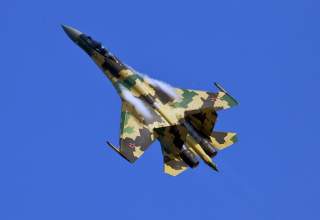China's Air Force May Soon Get More Russian Su-35 Fighters
Moscow and Beijing may have struck a deal.
Beijing is happy with the speed and quality of first Su-35 delivery, but makes local production prerequisite of more orders
Multiple sources within Russia and the People’s Liberation Army Air Force suggest that Beijing and Moscow may have struck a preliminary deal for procurement by the PLAAF of more of Russian-made Sukhoi Su-35 fighters.
Hong Kong-based military monthly Kanwa Defense Review reported in February that the second batch of the highly maneuverable aircraft with thrust-vectoring engines had already descended on PLA airbases in southern China.
Among those tipped as the likely locations to service and hangar the multi-role air-superiority fighters is the Suixi airbase in southern China’s Guangdong province, which is under the PLA’s Southern Theater Command.
Several Su-35s joined the PLA’s recent circumnavigations of Taiwan and air patrols above the South China Sea, along with Su-30s, H-6K bombers and jammer aircraft.
Recommended: America Has Military Options for North Korea (but They're All Bad)
Recommended: 1,700 Planes Ready for War: Everything You Need To Know About China's Air Force
Recommended: Stealth vs. North Korea’s Air Defenses: Who Wins?
In November 2015, the PLA became the first export customer for the Su-35 after Moscow and Beijing signed a US$2 billion contract for the purchase of 24 of the fighters. The first four aircraft were delivered in December 2016.
Citing sources within the Russian defense industry, the magazine noted that Su-35 producer Komsomolsk-on-Amur Aircraft Plant had been canvassing more orders after satisfactory feedback from the PLA about the speed and quality of the initial delivery batch.
The Su-35 was a modernized derivative of the Su-27 fighters earmarked for export in the late 1980s, but the disintegration of the Soviet Union and the West’s arms embargo clipped its wings, until orders from Beijing threw a lifeline.
Subsequent improvements have also been made to its cockpit, structural design and weapons-control system over the years.
It’s also said that Beijing has made it clear that more orders can only come under the parameters of knowledge transfer and localized production of some sub-systems and avionics, a tried and true tactic to replicate overseas technologies for cheaper, home-made alternatives.
Still, analysts say Russia may be willing to oblige now that there is a genuine rapport between the two powers, and a plethora of bilateral co-development and co-production of weapons and planes – ranging from cruise missiles to wide-body airliners – is also making headway.
Moscow curtailed arms transfers and cooperation around 2005 over Chinese reverse engineering of weapons systems, especially aircraft engines and components.
But now it has also agreed to sell China advanced S-400 air and missile defense systems, among others, after several years of lobbying by Beijing.
Meanwhile, the Indonesian Air Force also finalized the purchase contract for 11 Su-35s in February, with the first delivery expected by October. India and the United Arab Emirates are reportedly mulling possible purchases as well.
This article originally appeared on Asia Times.
Image: Wikimedia Commons

